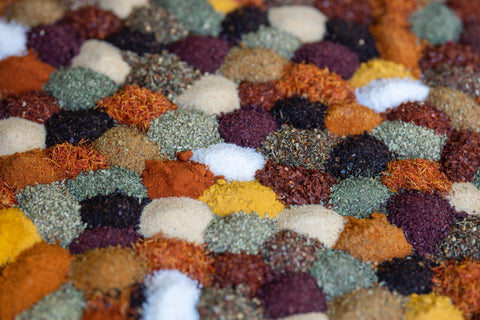In recent years, the use of synthetic dyes in food and skincare products has become a topic of considerable debate. These artificial colors, designed to make products more visually appealing, have been scrutinized for their potential health impacts. This article delves into the scientific research surrounding the side effects of synthetic dyes, offering a comprehensive overview for consumers and industry professionals alike.

What are Synthetic Dyes?
Synthetic dyes, also known as artificial colors, are chemically formulated substances used to enhance the appearance of food and skincare products. Unlike natural dyes derived from plants, minerals, or animals, synthetic dyes are created in laboratories and often have a more vibrant appearance. Common examples include Red 40, Blue 1, and Yellow 5.

Side Effects of Synthetic Dyes in Food
The impact of synthetic dyes in food has been the subject of numerous scientific studies. Research has indicated potential links between certain artificial colors and health issues:
Allergic Reactions:
Some individuals may experience allergic reactions to specific dyes, leading to symptoms like hives and asthma.
Certain synthetic dyes used in food and cosmetic products have been known to trigger allergic reactions in sensitive individuals. These reactions can range from mild symptoms like hives, characterized by itchy, red welts on the skin, to more severe respiratory issues such as asthma, which can manifest as difficulty breathing, coughing, and wheezing. The variability and severity of these allergic responses highlight the need for careful consideration and labeling of products containing synthetic dyes to safeguard susceptible consumers.
Behavioral Issues:
A study published in The Lancet investigated the effects of artificial food colors and additives on hyperactivity in children. The research was a randomized, double-blinded, placebo-controlled trial involving 3-year-old and 8/9-year-old children. The study found that artificial colors or a sodium benzoate preservative (or both) in the diet resulted in increased hyperactivity in children from the general population. You can access the study here.
Cancer Risk:
Certain dyes have been linked to an increased risk of cancer in animal studies. For example,
-
Red 3 (Erythrosine): This dye has been found to cause thyroid tumors in rats and has been partially banned by the FDA for use in cosmetics and externally applied drugs, but it is still used in food. A study in 1990 showed that very high doses of Red No. 3 can cause cancer in animals, and it has been linked to behavioral difficulties in children as well.
-
Red 40 (Allura Red), Yellow 5 (Tartrazine), and Yellow 6 (Sunset Yellow): These dyes have been found to be contaminated with benzidine or other carcinogens. Red 40 and Yellow 5, in particular, have been associated with hypersensitivity reactions and genotoxicity.
-
Citrus Red 2: This dye is used at low levels and only on some Florida oranges, but toxicity tests suggest safety concerns.
-
Blue 1 (Brilliant Blue), Blue 2 (Indigotine), Green 3 (Fast Green): Evidence suggests these dyes may cause cancer in animals, though the evidence is not conclusive.
It's important to note that while these dyes have shown carcinogenic effects in animal studies, the evidence in humans is less clear, and more research is needed to fully understand the risks. Nonetheless, the presence of these dyes in food raises concerns about unnecessary risks to human health, especially for young children

Synthetic Dyes in Skincare Products
In skincare, synthetic dyes are used for aesthetic purposes but pose different concerns:
Skin Irritation:
Artificial colors can cause skin irritation and sensitization, leading to conditions like dermatitis.
Additionally, the risk of dermatitis from artificial colors extends beyond immediate allergic reactions; it can also lead to chronic skin conditions with prolonged use. These synthetic dyes can disrupt the skin's natural balance and integrity, making it more susceptible to environmental stressors and other irritants. As consumers become more aware of these risks, there's a growing demand for skincare products free from artificial colors, leading to a shift in the industry towards more natural and skin-friendly alternatives.
Absorption and Systemic Effects:
There's ongoing research into how much of these dyes are absorbed through the skin and their potential systemic effects on the body.
Environmental Impact:
The production and disposal of synthetic dyes have environmental repercussions, including pollution and impact on aquatic life.
The environmental impact of synthetic dyes extends from their production, which often involves toxic chemicals and significant water pollution, to their disposal, which can contaminate waterways and harm aquatic ecosystems. These dyes can be resistant to degradation, leading to their accumulation in the environment where they pose a threat to aquatic life, disrupting food chains and affecting biodiversity.

Regulatory Stance and Consumer Awareness
Globally, regulatory agencies like the FDA in the United States and the European Food Safety Authority in Europe have set guidelines and limitations for the use of synthetic dyes. However, there's a growing consumer demand for transparency and the use of natural alternatives.

Conclusion
The side effects of synthetic dyes in food and skincare are a matter of ongoing scientific research and debate. While they offer aesthetic benefits, their potential health and environmental impacts cannot be overlooked. Consumers are advised to stay informed and consider products with natural coloring alternatives when possible.

